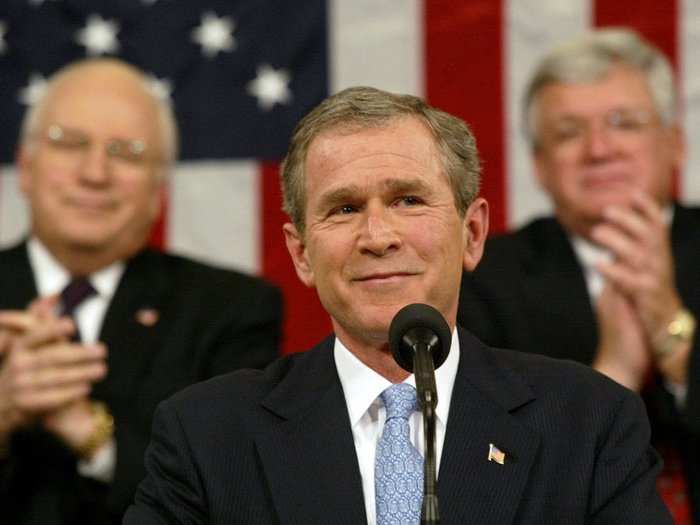
For more than a year after 9/11, the Bush administration made similar comments about Hussein's nuclear ambitions, and also his ties with terrorism.
"Simply stated, there is no doubt that Saddam Hussein now has weapons of mass destruction," Vice President Dick Cheney said in August 2002.
"We don't want the smoking gun to be a mushroom cloud," National Security Advisor Condoleeza Rice said on CNN in September 2002.
These statements, and others made by Secretary of Defense Donald Rumsfeld and Secretary of State Colin Powell, turned out to be based on faulty intelligence.
Some disagreed with the Bush administration's intelligence assessments, including former Commander of US Central Command Gen. Anthony Zinni, and even argued that the administration lied about Hussein's nuclear ambitions and links to terrorism.

The "shock and awe" bombing strategy was followed by an invasion of about 130,000 US troops.


A large sign reading "Mission Accomplished" hung behind him as Bush spoke, but in reality, the US military would fight a long, brutal insurgency for years after his speech.



In 2004, and in the coming years, US troops battled insurgents not just in Fallujah, but all across Iraq, including Mosul, Samarra, Najaf, Abu Ghraib (where it was discovered US troops were torturing and abusing detained Iraqis), and many more.

The incident shined light on a growing concern that US troops were often accidentally killing civilians.
One of the most egregious incidents came in 2007 when Blackwater contractors killed 17 Iraqi civilians in Nisour Square in Baghdad.

With nearly 900 killed, 2007 was also the bloodiest year for US troops in Iraq, which added to the growing anti-war sentiment among the American population.
Some of the sentiment, however, had been tempered over the previous four years by Bush's decision to not allow the media to photograph the coffins of returning US troops — something they knew helped the Vietnam protesters in the 1970s.
Source: NBC

Shortly after Obama's inauguration, he announced the drawdown from Iraq, which culminated in the last troops leaving in December 2011.
In total, the war in Iraq killed hundreds of thousands of Iraqi civilians, 4,500 American troops, and cost over $2 trillion.

ISIS, which was founded by Abu Musab al Zarqawi in 2004, entered Mosul in June 2014.

Whether learning from old mistakes or simply because there was a new administration with a different agenda, US troops this time were deployed mainly to train and support Iraqi security forces and Kurdish militias battling ISIS.

An AP investigation found that 9,000-11,000 civilians were killed in the battle for Mosul.

There remains disagreement about who or what is responsible for ISIS gaining so much ground in Iraq. Some blame Bush's initial invasion, some blame Obama's drawdown.
While the two are not mutually exclusive, it cannot be denied that the Bush administration initiated the fighting.
Source: CNN
 Average housing prices up 10% in Jan-Mar across the top eight cities
Average housing prices up 10% in Jan-Mar across the top eight cities
 Top visa-on-arrival picks for Indian explorers
Top visa-on-arrival picks for Indian explorers
 451 million voters! First four phases of Lok Sabha elections witness 66.95% voter turnout so far
451 million voters! First four phases of Lok Sabha elections witness 66.95% voter turnout so far

Copyright © 2024. Times Internet Limited. All rights reserved.For reprint rights. Times Syndication Service.